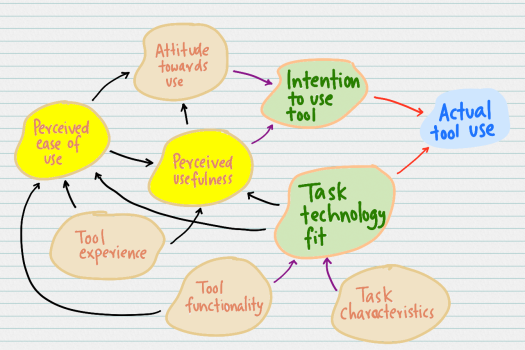
For many of us, a standard work IT package consisted of a laptop or desktop and a Microsoft Office suite.
That has let us do most things for a number of years, and remains a solid foundation for the kind of day-to-day office work we need to complete.
In most functions, however, the number of tool options are exploding.
Take the graphic below from Scott Brinkler who writes the Chief Marketing Technologist Blog. It shows the marketing technology landscape where we can now choose from 5,381 solutions from 4,891 unique companies - and has grown from around 150 to 5000+ in six years.

A similar transformation, although less dramatic, is happening across other organisational functions.
What are the things that managers who are tasked with investing in tools for users that need information systems and tool developers trying to develop such tools need to keep in mind - given the inevitable competition they will face?
One approach comes from a paper by Mark T. Dishaw and Diane M. Strong that puts forward an integrated model that tries to explain the likelihood of tool actually being used.
It combines two existing models, and the new, extended version is more effective than either alone.
First, the Technology Acceptance Model (TAM) suggests that actual tool use depends strongly on an intention to use the tool.
The strength of the intention depends on the user's attitude towards use, which in turn is a result of his or her perception of how useful the tool might be and how easy it is to use.
The Task-Technology Fit Model (TTF) focuses instead on the ability of technology to support a task - and matches the technology to what the task demands.
This fit depends on the tool functionality and the task characteristics - and suggests that a rational assessment that matches functions to tasks will result in the best choice of solutions.
The TAM depends on perception and attitude while the TTF focuses on rationality and comparison.
In reality, we use both, and the extended model, shown in adapted form in the picture above, is an integrated model that selects from parts of the TAM and TTF and connects them with the hypotheses set out in the paper.
It turns out that this extended model explains more about actual tool use than either model on its own.
How can we use this when selecting and implementing a technology stack in our organisations?
To start with, this model gives us an approach to scope what is required in terms of both technical capability and user-centric capacity.
All too often we select a package based on the sales pitch and technical functionality, forgetting that the value it will add depends on how the people in our organisation use it - and they will default to using systems they find easy and useful.
And the quality of our choice will show up in the statistics of actual tool use.
Hi! I am a robot. I just upvoted you! I found similar content that readers might be interested in:
https://karthik-suresh.com/2018/03/26/when-will-a-new-app-or-it-solution-benefit-our-work/
Congratulations @karthiksuresh! You have completed some achievement on Steemit and have been rewarded with new badge(s) :
Click on any badge to view your own Board of Honor on SteemitBoard.
To support your work, I also upvoted your post!
For more information about SteemitBoard, click here
If you no longer want to receive notifications, reply to this comment with the word
STOP